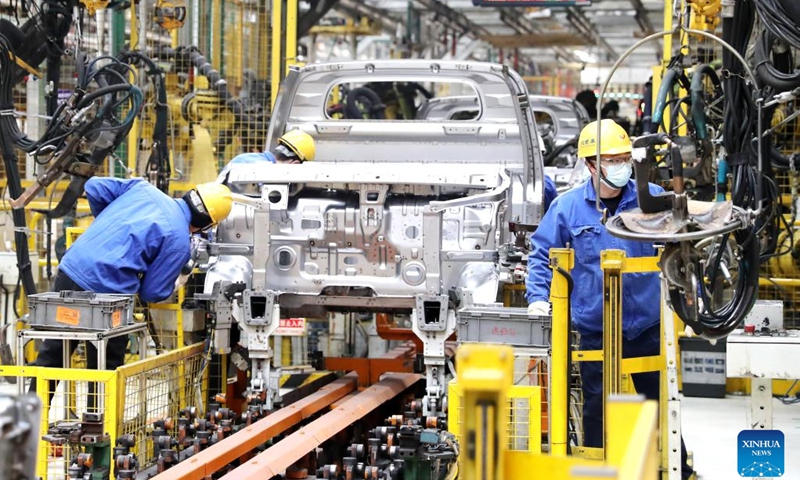
Staff members work at a workshop of an auto manufacturing enterprise in Qingdao, east China's Shandong Province, Jan. 28, 2023. Factories and companies across China resumed work after the Spring Festival holiday.(Photo: Xinhua)
China's value-added industrial output increased by 3.7 percent year-on-year in July, while retail sales grew by 2.5 percent year-on-year, according to official data released on Tuesday. Although the reading was lower than that of June, China's high-quality development pattern continues and the Chinese economy continues to recover amid persistent downward pressure, according to officials.
Despite the current pressure, the world's second-largest economy will remain on a recovery trend in the second half of the year, as the Chinese government's series of supportive policies land and take effect, experts said.
Value-added industrial output of major industrial enterprises in China rose by 3.7 percent year-on-year in July, down with June's reading of 4.4 percent, according to data released by the National Bureau of Statistics (NBS) on Tuesday.
Retail sales, a crucial economic indicator, grew by 2.5 percent year-on-year. The reading was lower than that of June, when total retail sales expanded 3.1 percent.
In the first seven months of 2023, value-added industrial output grew 3.8 percent year-on-year while retail sales expanded by 7.3 percent year-on-year, according to the NBS.
Fixed-asset investment in the first seven months continued to scale up with an increase of 3.4 percent, while investment in high-tech industries grew fast, expanding 11.5 percent over the same period.
The service sector sees fast growth, with modern service industries showing a sound growth momentum.
The Index of Service Production increased by 5.7 percent year-on-year, with that of accommodation and catering expanding by 20 percent.
"In July, the national economy continued to recover with the high-quality development making solid progress. However, we should be aware that the international political and economic situation is intricate and complicated, while the domestic demand remains insufficient and the foundation for economic recovery needs to be further consolidated," Fu Linghui, an NBS spokesperson, told a press conference on Tuesday after July economic indicators, closely watched as being the first month in the second half, were released.
Slowdowns of some of the key economic indicators in July are normal fluctuations between monthly readings, said Fu. "In general, national economy continues to recover though we must be aware of the challenges ahead."
Fu noted that in the next stage, China will intensify the role of macro policies in regulating the economy and will make solid efforts to expand domestic demand, shore up confidence and prevent risks.
Zhou Maohua, an economist at Everbright Bank, told the Global Times on Tuesday that the weaker readings of July indicated a weaker momentum in the economic rebound, while the slower domestic demand recovery and shrinking overseas demand have highlighted the need for more pro-growth policies in the weak link of the economy, key emerging sectors and the property sector.
However, the industrial sector has shown its resilience despite the impact of high temperatures and particle flooding, while the consumption sector is set to recover further as consumer confidence improves in the second half of the year, Zhou said.
In recent weeks, the Chinese government has rolled out a flurry of supportive policies to shore up the economy, with measures to bolster a wide range of sectors from property market to consumption. It also rolled out specific measures to boost the private sector, a vital source of jobs, and the rural areas, which are believed to have growth potential. A number of cities have rolled out favorable policies to boost housing sales.
On Tuesday, the People's Bank of China cut its seven-day reverse repo rate by 10 basis points to 1.8 percent and lowered interest rate of medium-term lending facility (MLF) by 15 basis points to 2.5 percent, injecting further liquidity into the banking system after the rate cut of June.
On Monday, Chinese authorities released guidelines to
promote high-quality development of rural circulation, as part of a national campaign to build a nationwide unified market and unleash the consumption potential of rural areas to ensure long-term stable economic growth.
At the end of July, China's National Development and Reform Commission (NDRC), the country's top economic planner, unveiled 20 administrative measures to spur domestic spending, vowing to stabilize spending on big-ticket items such as cars, expand service consumption and boost consumption in rural areas.
Global Times




